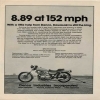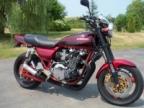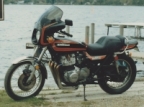Side cover repair
- bluej58
-
 Topic Author
Topic Author
- Offline
- Sustaining Member
- The chrome don't get you home
- Posts: 2481
- Thanks: 511
Side cover repair
17 Mar 2012 11:34
I'm ready to start putting the bike back together this coming week but I will have to wait for a new paint job.
Got a real nice replacement cover from Brian / kz10006 but it's black and I'm not going to try and match 25 year + paint.
Can someone tell me what I can use that will stick to an American side cover to build a temporary tab to get me through the season ?
Thanks , JD
Got a real nice replacement cover from Brian / kz10006 but it's black and I'm not going to try and match 25 year + paint.
Can someone tell me what I can use that will stick to an American side cover to build a temporary tab to get me through the season ?
Thanks , JD
78 KZ1000 A2A
Please Log in or Create an account to join the conversation.
- gd4now
-

- Offline
- User
- Denco where did you go?
- Posts: 1466
- Thanks: 507
Re: Side cover repair
17 Mar 2012 15:14
I have used zip ties and an old solder iron to plastic weld with good results. If you do not have the broken off piece then there are products that will make use of a known good pin to mold a new one. Like this site
www.plastex.net/index.php?pr=Home_Page
There are others just do a google search for plastic repair.
1977 KZ650 B1
Pods and Denco header
OLD KAW OWNERS SMILE ALOT
Pods and Denco header
OLD KAW OWNERS SMILE ALOT
Please Log in or Create an account to join the conversation.
- mark1122
-

- Offline
- User
- Keep twisting it
- Posts: 5359
- Thanks: 109
Re: Side cover repair
17 Mar 2012 15:43
if this is just to get u through the summer. u could put a hole in the side, put a zip tie though and then attach a spring and hook from the tie to something under the seat ??
been there done that. :laugh:
been there done that. :laugh:
76 KZ, frame gusset work,1200CC.Ported by Larry Cavanaugh, 1.5mm.over intakes, Carron Pipe, ZRX12 rear end, and seat,96zx9 front end.
01 CBR600F4i Track bike.
Cobourg, Ont. Can.
~ ~ ~_@
~ ~ _- \,
~ (k) / (z)
01 CBR600F4i Track bike.
Cobourg, Ont. Can.
~ ~ ~_@
~ ~ _- \,
~ (k) / (z)
Please Log in or Create an account to join the conversation.
- bluej58
-
 Topic Author
Topic Author
- Offline
- Sustaining Member
- The chrome don't get you home
- Posts: 2481
- Thanks: 511
Re: Side cover repair
18 Mar 2012 17:23
That Plastex looks like cool stuff, and only 14 bucks + shipping for the kit,and should be enough to do what I need done, if I don't screw it up :dry:
I also like your idea Mark , I may do a hybrid along those lines by trying to form a level surface with fiberglass then add the spring and wire.
Thanks guys
JD
I also like your idea Mark , I may do a hybrid along those lines by trying to form a level surface with fiberglass then add the spring and wire.
Thanks guys
JD
78 KZ1000 A2A
Please Log in or Create an account to join the conversation.
- KZQ
-
- Offline
- Administrator
- Walking Behind the Corn May Not Be All That!
- Posts: 4892
- Thanks: 1528
Re: Side cover repair
18 Mar 2012 22:31 - 18 Mar 2012 22:57
Most street motorcycle plastic bodywork is made with either Styrene or ABS plastic. Here's a method for repairing these bodywork panels that's effective and inexpensive.
I've repaired any number of motorcycle side covers and fairings over the years. Up until now my stand by material was JB Weld. Even though I knew that it didn't adhere to any plastics very well. Today there are many plastic repair epoxies that actually do adhere to a wide range of plastics. My first comment is that: Most of them smell like nerve poison, Seconded quickly by my stumbling on their unit costs. You know that they're exotic chemicals because you're Paying for Exotic Chemicals!!! I don't pretend to be a chemical engineer and I've never worked in a body shop, but recently I did have a momentary flash of understanding that may make your plastic repair experience less expensive and significantly easier. For purposes of this discussion, since I'm not an enjuneer, I'd like to divide motorcycle plastics into three crude categories.
1) Black plastic, usually ABS.
2) Chromed plastic, usually a sputtered metallic coating on what I loosely refer to as styrene plastic.
3) Polyethylene plastics, usually used on dirt bikes and personal water craft because they are very flexible and float.
Black or ABS plastic: Currently I'm repairing a chopped down fairing for my 85 1300. It has several large stress fractures that I think are caused by vibration and flexure. I could see that the PO had applied some sort epoxy filler in futile attempt to reinforce the cracks. His effort failed when the epoxy filler split at the same locations, probably because it was much stiffer than the plastic. I used a wood chisel to split most of the thicker sections of his epoxy off of the plastic and cleaned the area with alcohol. In the past at this point I had usually resorted to fiberglass fabric and JB Weld, which probably would have sufficed this time except that this effort was going to consume way more JB Weld than I had ever used before. I knew that whatever I tried would have to incorporate some sort of fiber reinforcement. I also knew that the plastic was ABS. It took a while but I finally realized that there was no reason why I couldn't use fiberglass fabric for the reinforcement and black ABS pipe cement for the adhesive/resin. It worked great! It's the perfect combination. Cheap, Fast and Durable! And the results look like they grew that way with no sanding. Probably a good idea to use gloves as ABS cement is toxic and is not easily removed from your hands. You can also use the "universal" cement as long as it says ABS on the can.
Here's the crack before I went after it.
Here it is with the fabric bedded into the glue.
And with a topping coat worked into the fabric.
Here's the inside surface.
The glue cured up smooth and hard in about an hour.
Chromed plastic, styrenes as far as I need to know. I've repaired styrene plastic with a similar technique. Here is a styrene side cover from my 1300 Voyager that had the lower post broken off. In this first picture I've scraped off the chrome covering to expose the cream colored plastic, which I believe is styrene. I cleaned the whole area with denatured alcohol and then used plastic model cement to glue the post back in place.
Of course model cement alone would never be strong enough so I used fiberglass fabric to reinforce the base connection. Here's a picture of the fabric laid into a wet layer of model cement. There are actually two layers of fiberglass fabric. The model cement anchors the fiberglass soundly to the base plastic.
Here's the post after I've trimmed up the glass fabric and applied another coat of model cement.
One more view:
That brings us to the polyethylene's, the floating plastics, these are really unimportant as they have never been used on KZs
Thanks
Bill R
I've repaired any number of motorcycle side covers and fairings over the years. Up until now my stand by material was JB Weld. Even though I knew that it didn't adhere to any plastics very well. Today there are many plastic repair epoxies that actually do adhere to a wide range of plastics. My first comment is that: Most of them smell like nerve poison, Seconded quickly by my stumbling on their unit costs. You know that they're exotic chemicals because you're Paying for Exotic Chemicals!!! I don't pretend to be a chemical engineer and I've never worked in a body shop, but recently I did have a momentary flash of understanding that may make your plastic repair experience less expensive and significantly easier. For purposes of this discussion, since I'm not an enjuneer, I'd like to divide motorcycle plastics into three crude categories.
1) Black plastic, usually ABS.
2) Chromed plastic, usually a sputtered metallic coating on what I loosely refer to as styrene plastic.
3) Polyethylene plastics, usually used on dirt bikes and personal water craft because they are very flexible and float.
Black or ABS plastic: Currently I'm repairing a chopped down fairing for my 85 1300. It has several large stress fractures that I think are caused by vibration and flexure. I could see that the PO had applied some sort epoxy filler in futile attempt to reinforce the cracks. His effort failed when the epoxy filler split at the same locations, probably because it was much stiffer than the plastic. I used a wood chisel to split most of the thicker sections of his epoxy off of the plastic and cleaned the area with alcohol. In the past at this point I had usually resorted to fiberglass fabric and JB Weld, which probably would have sufficed this time except that this effort was going to consume way more JB Weld than I had ever used before. I knew that whatever I tried would have to incorporate some sort of fiber reinforcement. I also knew that the plastic was ABS. It took a while but I finally realized that there was no reason why I couldn't use fiberglass fabric for the reinforcement and black ABS pipe cement for the adhesive/resin. It worked great! It's the perfect combination. Cheap, Fast and Durable! And the results look like they grew that way with no sanding. Probably a good idea to use gloves as ABS cement is toxic and is not easily removed from your hands. You can also use the "universal" cement as long as it says ABS on the can.
Here's the crack before I went after it.
Here it is with the fabric bedded into the glue.
And with a topping coat worked into the fabric.
Here's the inside surface.
The glue cured up smooth and hard in about an hour.
Chromed plastic, styrenes as far as I need to know. I've repaired styrene plastic with a similar technique. Here is a styrene side cover from my 1300 Voyager that had the lower post broken off. In this first picture I've scraped off the chrome covering to expose the cream colored plastic, which I believe is styrene. I cleaned the whole area with denatured alcohol and then used plastic model cement to glue the post back in place.
Of course model cement alone would never be strong enough so I used fiberglass fabric to reinforce the base connection. Here's a picture of the fabric laid into a wet layer of model cement. There are actually two layers of fiberglass fabric. The model cement anchors the fiberglass soundly to the base plastic.
Here's the post after I've trimmed up the glass fabric and applied another coat of model cement.
One more view:
That brings us to the polyethylene's, the floating plastics, these are really unimportant as they have never been used on KZs
Thanks
Bill R
www.KZ1300.com
Riders:
1968 BSA 441 Shooting Star, 1970 BSA 650 Lightning, 1974 W3, 1976 KZ900, 1979 KZ750 Twin, 1979 KZ750 Twin Trike, 1981 KZ1300, 1982 KZ1100 Spectre, 2000 Valkyrie, 2009 Yamaha Roadliner S. 1983 GL 1100
Projects:
1985 ZN1300
Riders:
1968 BSA 441 Shooting Star, 1970 BSA 650 Lightning, 1974 W3, 1976 KZ900, 1979 KZ750 Twin, 1979 KZ750 Twin Trike, 1981 KZ1300, 1982 KZ1100 Spectre, 2000 Valkyrie, 2009 Yamaha Roadliner S. 1983 GL 1100
Projects:
1985 ZN1300
Last edit: 18 Mar 2012 22:57 by KZQ.
The following user(s) said Thank You: guitargeek, bluej58
Please Log in or Create an account to join the conversation.
- bluej58
-
 Topic Author
Topic Author
- Offline
- Sustaining Member
- The chrome don't get you home
- Posts: 2481
- Thanks: 511
Re: Side cover repair
19 Mar 2012 00:37
Now that's cool, I think I'll go find a pc. of ABS and carve something up.
Thanks Bill.
JD
Thanks Bill.
JD
78 KZ1000 A2A
Please Log in or Create an account to join the conversation.
- martin_csr
-

- Offline
- User
- Posts: 8019
- Thanks: 1645
Last edit: 21 Feb 2013 15:41 by martin_csr.
Please Log in or Create an account to join the conversation.
- bluej58
-
 Topic Author
Topic Author
- Offline
- Sustaining Member
- The chrome don't get you home
- Posts: 2481
- Thanks: 511
Re: Side cover repair
22 Mar 2012 14:53 - 02 Jan 2013 20:38
OK, I went to the Farm and Fleet hoping they had ABS piping and glue, no luck.
They did have this epoxy that has ABS at the top of the list along with steel, so for 3 bucks I went for it.
Guess what, It freakin worked :woohoo:
Here are the results
I found this plastic wrench at home and I borrowed the end from, it's hard but I'm not positive that it is ABS, I used it any way .
I filled the underside with epoxy and cut it off
I tacked the tab in place with a couple small dabs of hot glue.
I used my spare black side cover to make impressions in the card board for use as a template .
They did have this epoxy that has ABS at the top of the list along with steel, so for 3 bucks I went for it.
Guess what, It freakin worked :woohoo:
Here are the results
I found this plastic wrench at home and I borrowed the end from, it's hard but I'm not positive that it is ABS, I used it any way .
I filled the underside with epoxy and cut it off
I tacked the tab in place with a couple small dabs of hot glue.
I used my spare black side cover to make impressions in the card board for use as a template .
78 KZ1000 A2A
Last edit: 02 Jan 2013 20:38 by bluej58.
Please Log in or Create an account to join the conversation.
- bluej58
-
 Topic Author
Topic Author
- Offline
- Sustaining Member
- The chrome don't get you home
- Posts: 2481
- Thanks: 511
Please Log in or Create an account to join the conversation.
- Mcdroid
-

- Offline
- User
- Gone Kwackers
- Posts: 6697
- Thanks: 360
Re: Side cover repair
22 Mar 2012 15:32
Nice job with the photo essay...very helpful!
Michael
Victoria, Texas
1982 GPz750
1977 KZ1000A
1978 KZ1000A
1982 GPz1100
1975 Z2A
Victoria, Texas
1982 GPz750
1977 KZ1000A
1978 KZ1000A
1982 GPz1100
1975 Z2A
The following user(s) said Thank You: bluej58
Please Log in or Create an account to join the conversation.
- KZJOE900
-

- Offline
- Admin
- Posts: 1972
- Thanks: 445
Re: Side cover repair
16 Jun 2013 18:56
JD, how has your repair held? I have been researching products in preparation to repair a cracked side cover. Looking for a repair material which some flex to it. I would love to get the Weld-on 810 but seems to be for industrial sale only. The other options are Plastex, which is too expensive and I might as well invest the money into a replacement cover at that point. Another is the Loctite Epoxy Plastic Bonder which is like $6 from Home Depot. Other option I am considering is what you used: Permatex PermaPoxy Plastic Weld, which seems to have the same properties as the Loctite one. So if yours has held up well, I think I will go ahead and try it. Thanks in advance.
Current project 76 KZ900 (This was a Vetter model)
76 KZ900
81 XJ550H SECA (Current Project)
82 XJ550R SECA
Past:
86 FJ1200
74 Z1900
72 CB450
76 KZ900
81 XJ550H SECA (Current Project)
82 XJ550R SECA
Past:
86 FJ1200
74 Z1900
72 CB450
Please Log in or Create an account to join the conversation.
- bluej58
-
 Topic Author
Topic Author
- Offline
- Sustaining Member
- The chrome don't get you home
- Posts: 2481
- Thanks: 511
Re: Side cover repair
16 Jun 2013 21:57
Hey Joe, it's holding up very well, 9500 miles so far.
There is no flex to this product though and if you are using it for a crack I would back it up with a piece of ABS or some other material that they say it will stick to.
Please document what you are doing if you can.
JD
Here's what it looks like now .
There is no flex to this product though and if you are using it for a crack I would back it up with a piece of ABS or some other material that they say it will stick to.
Please document what you are doing if you can.
JD
Here's what it looks like now .
78 KZ1000 A2A
The following user(s) said Thank You: KZJOE900
Please Log in or Create an account to join the conversation.








